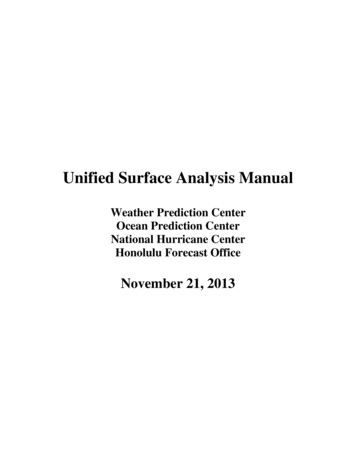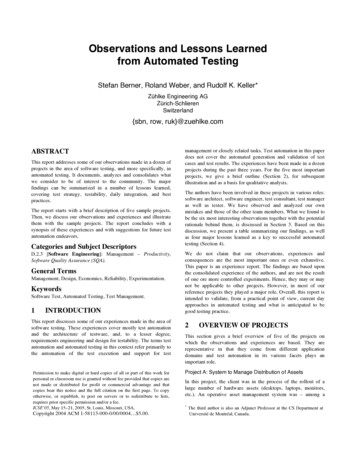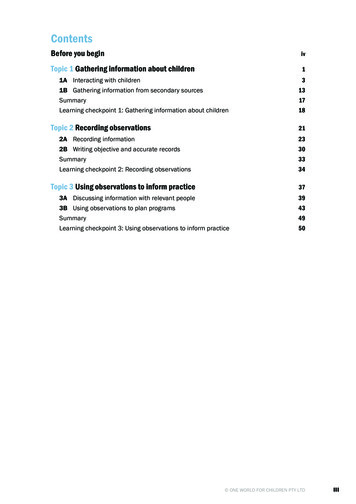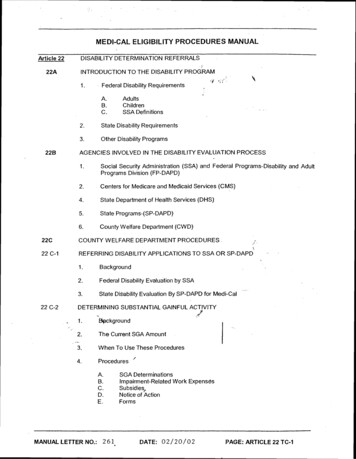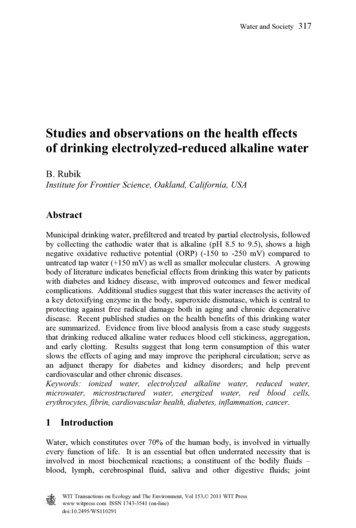
Transcription
Water and Society317Studies and observations on the health effectsof drinking electrolyzed-reduced alkaline waterB. RubikInstitute for Frontier Science, Oakland, California, USAAbstractMunicipal drinking water, prefiltered and treated by partial electrolysis, followedby collecting the cathodic water that is alkaline (pH 8.5 to 9.5), shows a highnegative oxidative reductive potential (ORP) (-150 to -250 mV) compared tountreated tap water ( 150 mV) as well as smaller molecular clusters. A growingbody of literature indicates beneficial effects from drinking this water by patientswith diabetes and kidney disease, with improved outcomes and fewer medicalcomplications. Additional studies suggest that this water increases the activity ofa key detoxifying enzyme in the body, superoxide dismutase, which is central toprotecting against free radical damage both in aging and chronic degenerativedisease. Recent published studies on the health benefits of this drinking waterare summarized. Evidence from live blood analysis from a case study suggeststhat drinking reduced alkaline water reduces blood cell stickiness, aggregation,and early clotting. Results suggest that long term consumption of this waterslows the effects of aging and may improve the peripheral circulation; serve asan adjunct therapy for diabetes and kidney disorders; and help preventcardiovascular and other chronic diseases.Keywords: ionized water, electrolyzed alkaline water, reduced water,microwater, microstructured water, energized water, red blood cells,erythrocytes, fibrin, cardiovascular health, diabetes, inflammation, cancer.1 IntroductionWater, which constitutes over 70% of the human body, is involved in virtuallyevery function of life. It is an essential but often underrated necessity that isinvolved in most biochemical reactions; a constituent of the bodily fluids –blood, lymph, cerebrospinal fluid, saliva and other digestive fluids; jointWIT Transactions on Ecology and The Environment, Vol 153, 2011 WIT Presswww witpress com ISSN 1743-3541 (on-line)doi:10.2495/WS110291
318 Water and Societylubrication; detoxification; and maintaining the blood pressure. Yet it is far morethan just a constituent. A new science of water is emerging in which thestructure and dynamics of water is much more complex than was previouslythought. Water is a complex dynamic liquid sensitive and responsive to itsenvironment. We are now in the midst of a paradigm shift in which liquid wateris seen as an active agent rather than a passive constituent or universal solvent oflife. For example, water and living systems are equally sensitive to a singlequantum of magnetic flux [1]. Water shows long-range ordering features aroundcell membranes, where is it more like an epitaxial liquid crystal with distinctproperties in those regions that radically distinguish it from bulk water [2] whilechemically still remaining H2O. It used to be thought that water was passive,“dancing to the tune of biomolecules”, but now, water is considered the “matrixof life.”The greatest physiological change with aging is not within our biomolecules,but in the loss of water from the body. The body of a young infant consists ofover 80% water, but that of a person over 70 years old is typically comprised ofless than 60% water.There are many concerns about drinking water quality worldwide today.Many people choose to drink commercially bottled water for various reasons, butits healthfulness is questionable. Some device manufacturers claim that watertreated by a vortex, electromagnetic fields, or other physical means to “energize”it, is more healthful than untreated waters and may also slow the aging process.In this paper, we review published evidence for the impact on health of drinkinga particular type of water called “electrolyzed-reduced” water and showobservations from the blood.2 Background and literature reviewAlkaline mineral water with a relatively high negative oxidative reductivepotential (ORP -150 to -300 millivolts) and a pH over 8.0 is characteristic ofnatural mountain streams and certain deep wells. Aside from these naturalsources, where can one find water with these properties? If this natural waterwere to be bottled, it would lose its high negative ORP and may react withplastic bottles that contain phthalates, toxic carcinogens. Nonetheless, one cangenerate water with these properties at point-of-use by using a device called anionizer. This is a commercially available water treatment system for the homethat first filters the water through a multi-stage filter to remove chlorine,chloramine, and other contaminants, and then performs partial electrolysis of thefiltered water over platinum-coated titanium electrodes with a DC electric field.This yields 2 fractions: oxidized acidic water from the anode, and reducedalkaline water from the cathode. The reduced alkaline water appears to matchmost closely natural mountain spring water at the source in its physicalproperties and taste. This water is the subject of this paper. It has been called byvarious names: reduced, electrolyzed-reduced, and alkaline ionized water, toname a few. In this paper, we refer to it as ERW, “electrolyzed-reduced water.”The ERW fraction retains the alkaline ionic minerals from the tap water,WIT Transactions on Ecology and The Environment, Vol 153, 2011 WIT Presswww witpress com ISSN 1743-3541 (on-line)
Water and Society319including calcium and magnesium, which are important minerals for health, hasa high negative ORP, an alkaline pH, a low level of dissolved oxygen, and ismicrostructured, with 5 to 6 molecules of water per cluster. It also has a lowersurface tension than the starting tap water, which makes it a better solvent andmay improve hydration.Most of the studies on ERW have been conducted in Japan, Korea, and China.Not all of the research reports have been translated into English. Peer-reviewedstudies from various laboratories worldwide show that ERW, with its highnegative ORP, scavenges free radical chemical species, protecting fromoxidative damage. This, along with its alkalinity and microstructure, yieldnumerous health benefits.In addition, clinical reports, with or withoutcontrolled studies supporting them, further suggest that ERW produces declinesin blood sugar levels in diabetic patients; improvements in peripheral circulationin diabetic gangrene; improvements in intestinal flora; declines in uric acid levelsin patients with gout; improvements in liver function tests in hepatic disorders;improvements in gastroduodenal ulcer with prevention of recurrences; improvedhydration and fluid replacement; and improvements in blood pressure in the caseof either hypertension or hypotension. Here we summarize some of the keyfindings from the peer-reviewed literature on humans and other biologicalsystems.2.1 Active reducing agent and protection against oxidative stressShirahata et al. studied the properties of ERW and reported that it showed asuperoxide dismutase-like activity in protecting against oxidative damage,alleviating oxidative damage of DNA molecules and other species in vitro [3].This antioxidant effect of ERW has been verified [4]. The nature of the reducingspecies (antioxidant) in ERW has been proposed to be active hydrogen and/ormolecular hydrogen, but it is not the same as ordinary hydrogen gas and remainsunresolved [5, 6]. One group reports that ERW contains both atomic andmolecular hydrogen [7]. ERW prevented oxidative cleavage of proteins and alsostimulated the activity of free radical scavenger, ascorbic acid [8]. Rats, upondrinking ERW for just one week, showed significantly reduced amounts ofperoxidized lipid in their urine, suggesting reduced oxidative stress in the rats[9]. These studies document that ERW has strong antioxidant activity.Antioxidant activity is important to protect cells and biomolecules from the toxiceffects of oxidative damage associated with reactive oxygen species such assuperoxide radicals that are associated with the biochemistry of inflammationand implicated as underlying factors in chronic disease.2.2 Prolonged lifespan in nematodes and miceIt is well accepted that oxidative damage culminates in many of the maladies ofaging, so that a drinking water with antioxidant activity might be helpful tomitigate the ravages of aging and possibly slow it down. G. Fernandes at theUniversity of Texas reported that various strains of mice fed ERW from birthlived 20 to 50% longer. He also found reduced serum peroxide levels in theseWIT Transactions on Ecology and The Environment, Vol 153, 2011 WIT Presswww witpress com ISSN 1743-3541 (on-line)
320 Water and Societymice compared to control mice fed tap water [10]. Landis and Tower showedthat enhanced activity of superoxide dismutase, as has been demonstrated byvarious investigators using ERW, can reduce oxidative damage and extend lifespan [11].A study on ERW used in the aqueous medium of the nematode (worm),C. Elegans in laboratory cultures showed that it significantly extended itslifespan, which has been interpreted to be at least in part due to the reactiveoxygen species (ROS)-scavenging action of ERW [12].2.3 Studies on kidney disease and use of hemodialysisIn end-stage kidney-diseased patients on dialysis, ERW appears to have abeneficial effect on reduction of hemodialysis-induced oxidative stress. Huanget al. studied the reactive oxygen species in the plasma of these patientsand found that ERW diminished hemodialysis-enhanced peroxide levels,and minimized oxidized and inflammatory markers (C-reactive protein andinterleukin-6) after 1 month of drinking ERW. These findings suggest thatcardiovascular complications (stroke and heart attack) in these kidney dialysispatients might be prevented by ERW [13].Another study investigated use of ERW directly in the hemodialysis processof 8 kidney patients, and found that the viability of patients’ polymorphonuclearleukocytes was better preserved [14].2.4 Studies on diabetes and blood glucose levelsReactive oxygen species (ROS), such as superoxide and other free radicaloxygen species, are known to cause reduction of glucose update by inhibiting theinsulin-signaling pathway in cultured cells. Therefore, the scavenging of ROS isimportant to the control of diabetes. ERW scavenged intracellular ROS andstimulated glucose uptake in the presence or absence of insulin in rat L6 skeletalmuscle cells and mouse 3T3/L1 adipocytes. This insulin-like activity of ERWwas inhibited by wortmannin, a specific inhibitor of PI-3 kinase, a key moleculein insulin signalling pathways. ERW protected insulin responsive cells fromsugar toxicity and improved the damaged sugar tolerance of type II diabetesmodel mice. This suggests that ERW may improve the status of those withinsulin-independent diabetes mellitus [15].Oxidative stress is produced under diabetic conditions and involved inprogression of pancreatic beta-cell dysfunction. ERW in diabetic mice improvedislet beta-cell function, resulting in increased release of circulating insulin andimproved insulin sensitivity in both type I and type II diabetes [16, 17]. In astudy on Otsuka Long-Evans Tokushima Fatty (OLETF) rats, ERW given to onegroup showed significantly lower blood glucose levels than controls given tapwater. Moreover, blood levels of triglycerides and total cholesterol alsodecreased in the rats fed ERW [18].A study on 411 type II diabetes patients whose average age was 71.5 years,who drank natural reduced water from the Nordenau Spring in Germany, up to2 liters per day over 6 days, showed that 186 (45%) responded positively, withWIT Transactions on Ecology and The Environment, Vol 153, 2011 WIT Presswww witpress com ISSN 1743-3541 (on-line)
Water and Society321reduced blood glucose, improved cholesterol, LDL, HDL, and serum creatininelevels. 70.6% of a random sample of 136 of the patients also showed a decreasein blood ROS [19].Recent bioelectrical impedance analysis studies showed that diabetics have alower ratio of intracellular water (ICW) to extracellular water (ECW). 336 typeII diabetics were recruited in a randomized, double-blind trial. The subjectsreceived 250 ml of ERW or distilled water twice daily for 4 weeks. Resultsshow that ERW consumption improved cell water distribution (ICW/ECW),basal metabolism rate, and cell capacitance during the 4-week period. Theauthors speculate that the relatively small size of the water molecule clusters inERW may underlie the beneficial findings of improved cell structure andfunction [20].2.5 Stimulation of anaerobic microflora in the human gutThe high negative ORP of ERW favors the growth of key anaerobic bacteria inthe human gut that are important for normal intestinal microflora, health of thecolon, and optimum nutrition [21].2.6 Lack of toxicity in microbes, cells, and animalsERW used up to a concentration of 100% in the Ames Test with Salmonellatyphimurium did not show any bacterial mutations, either in the presence orabsence of rat liver for exogenous metabolic activation. Similarly, ERW did notinduce any chromosome aberrations in Chinese hamster lung fibroblast cellswith or without rat liver, for up to 24 hours. Rats administered ERW at a dose of20 mL/kg/day for 28 days via intragastric infusion did not show any clinicalsymptoms or toxic changes. These results demonstrate the expected safety for a60 kg human to drink at least 1.2L/day of ERW [22].Developing animals are the most sensitive to biological agents and are oftenused in studies to investigate toxicity. Thus, ERW was given to pregnant andalso lactating rats to look for any effects. Development of rat fetuses andoffspring were normal, and ERW increased the weight of the animalsover controls. ERW was also found to have positive biological effects onpostnatal growth. Moreover, postnatal morphological development was alsoaccelerated [23]. No significant difference in milk yield or suckled milk volumewas noted. It is suspected that the water-hydrated calcium cations transferred tothe fetus through the placenta and to the offspring through the milk, might be thecause of the increased body weight, since calcium plays a key role in skeletalformation [24].2.7 Inhibition of cancer but not normal cellsIt is known that tumor cells produce ROS more abundantly than normal cells. Itis also well known that antioxidants can inhibit tumor cell proliferation, whichindicates an important role of ROS in mediating the loss of growth control.Human tongue carcinoma cells were shown to be significantly inhibited forWIT Transactions on Ecology and The Environment, Vol 153, 2011 WIT Presswww witpress com ISSN 1743-3541 (on-line)
322 Water and Societyeither colony formation or colony sizes by ERW in cell cultures withoutinhibition to normal human tongue epithelial cells. ERW also caused growthinhibition, cell degeneration, and inhibition of invasion to human fibrosarcomacells HT-1080. These studies suggest that ERW may help prevent tumorprogression and invasion [25].In vitro examination of leukemia cells (HL-60) treated with ERW showedenhanced mitochondrial damage and cell apoptosis. However, normal peripheralblood mononuclear cells showed no cytotoxic effect from ERW [26]. ERW alsosuppressed the growth rate of cancer cells transplanted into mice, demonstratinganti-cancer effects in vivo.2.8 Protection of liver from toxic agentsMice with carbon tetrachloride-induced liver damage given ERW showedsignificantly lowered serum levels of hepatic enzyme markers and increasedactivities of superoxide dismutase and other key detoxifying enzymes. Theeffects of ERW were similar to silymarin, an extract from milk thistle wellknown for its hepato-protective properties. Results suggest that ERW may beused to protect the liver against toxins that induce oxidative damage [27].2.9 Conclusions from the literature reviewThese studies show impressive health benefits in humans and other biologicalsystems from consumption of ERW over a very short time, and without any toxiceffects observed. Clearly, ERW is a useful adjunct for treating ROS-associateddiseases, including diabetes, kidney disease, cancer, and cardiovascular disease.In addition, due to its anti-aging effects in scavenging oxygen free radicals,ERW appears to be an excellent choice for regular water consumption, althoughits antioxidant activity is unstable upon storage. Nonetheless, it is easilyproduced from tap water at point-of-use.3 Observations from live blood analysisThe blood is the most easily monitored tissue that can show rapid changes thatcorrelate with health and disease. We have observed that persons drinking ERWshow exceptionally clean biological terrains as monitored by live blood analysis.Live blood analysis is the visual examination of a small droplet of freshcapillary blood typically taken from the fingertip, put onto a glass slide, andimmediately observed under a high-powered light microscope equipped with adark-field condenser. This method offers a visual perspective of the blood cellsand plasma at high magnification enhanced by modern optical techniques. Itprovides an assessment of the ecology of the blood, the “biological terrain”.Live blood analysis is used clinically to look for the malaria and Lyme diseaseparasites. Here we discuss it as a tool to assess blood cell stickiness, clumping,and coagulation and clotting processes, which are related to the activation of theinflammatory cascade.WIT Transactions on Ecology and The Environment, Vol 153, 2011 WIT Presswww witpress com ISSN 1743-3541 (on-line)
Water and Society323A microphotograph from live blood analysis is shown in Figure 1. This is aphotograph of normal healthy blood of a fasted female, age 37. The red bloodcells (RBCs) are seen as single, free, round cells. Only a few platelet aggregatesare seen in the plasma as grey areas. No RBC stickiness and no other clottingfactors are found throughout the blood sample.Figure 1:Normal healthy blood from female, age 37.By contrast, Figure 2 shows the blood of a male, 65 years old. This blood isalso typical of that found in many elderly persons. The RBCs are sticky andtightly clumped together in rouleau (rolls of coins seen on edge). Fibrin (whitethreads) is present, indicating that blood coagulation and clotting have beenactivated. This is the picture of systemic inflammation.Peripheral circulation was also impaired for this subject, because only singleRBC can move freely through the smallest capillaries. Poor circulation in theextremities is a common complaint of the elderly.Following this test, the subject, M, age 65, drank 1 to 1.5 liters/day of ERWfrom an ionizer for 6 months but made no other changes in diet or lifestyle.Figure 3 shows the blood from the same person after 6 months. The RBCstickiness, aggregation, and clotting factors are no longer present. It isparticularly striking to see this change in an older person’s blood. Although thisis a single case presented here, numerous other cases have been observed as well.WIT Transactions on Ecology and The Environment, Vol 153, 2011 WIT Presswww witpress com ISSN 1743-3541 (on-line)
324 Water and SocietyFigure 2:Unhealthy blood from male, 65, showing blood congestion andclotting.4 ConclusionsChronic inflammation is considered to be one of the main underlying factors ofvirtually all of the chronic degenerative diseases, including cancer,cardiovascular, and autoimmune diseases. From observing changes in thebiological terrain apparently due to consumption of ERW, it appears that ERWmay be a useful intervention to mitigate activation of the clotting andinflammatory pathways. Long-term consumption of ERW may improve theblood circulation and possibly help prevent the chronic diseases of our times.Acid-alkaline balance is another key to health and wellness [28]. Metabolismof food leads to acid wastes, yet the biological terrain needs to be alkaline, pH7.2-7.4. Drinking alkaline water such as ERW can contribute to neutralizingacid waste and maintaining proper pH balance in the body.In conclusion, a growing body of scientific and clinical literature showsincreasing support for ERW as a “functional” drinking water that scavenges freeradicals, diminishes systemic inflammation, and is a useful adjunct for treatingROS-associated diseases, including diabetes, kidney disease, cancer, andcardiovascular disease. From observations of the blood, it appears to mitigateearly blood clotting and systemic inflammation seen as sticky, aggregated RBCsand fibrin. Collectively, this evidence points to ERW as a healthy drinking waterWIT Transactions on Ecology and The Environment, Vol 153, 2011 WIT Presswww witpress com ISSN 1743-3541 (on-line)
Water and SocietyFigure 3:325Blood of same male, 65, after drinking 1.5 liters ERW for6 months. This biological terrain is normal and healthy. Severalwhite blood cells are also seen here.that slow down the effects of aging. More research is recommended to furtherstudy its anti-aging and anti-inflammatory effects.References[1] Smith, C.W., Quanta and coherence effects in water and living systems.Journal of Alternative and Complementary Medicine, 10(1), pp. 69-79,2004.[2] Zheng, J.-M., Pollack, G.H., Solute exclusion and potential distributionnear hydrophilic surfaces. In: Water and the Cell, eds Pollack, G.H.,Cameron, I.L., Wheatley, D.N., Springer: Dordrecht, the Netherlands,pp. 165-174, 2006.[3] Shirahata, S., Kabayama, S., Nakano, M., Miura, T., Kusumoto, K., Gotoh,M., Hayashi, H., Otsubo, K., Morisawa, Y. and Katakura, Y., Electrolyzedreduced water scavenges active oxygen species and protects DNA damage.Biochem. Biophys. Res. Commun., 234, pp. 269–274, 1997.[4] Hanaoka, K., Sun, D., Lawrence, R., Kamitani, Y., Fernandes, G., Themechanism of the enhanced antioxidant effects against superoxide anionradicals of reduced water produced by electrolysis. Biophysical Chemistry107, pp. 71-82, 2004.WIT Transactions on Ecology and The Environment, Vol 153, 2011 WIT Presswww witpress com ISSN 1743-3541 (on-line)
326 Water and Society[5] Hiraoka, A., Takemoto, M., Suzuki, T., Shinohara, A., Chiba, M., Shirae,M., Yoshimura, Y., Studies on the properties and real existence of aqueoussolution systems that are assumed to have antioxidant activities by theaction of “active hydrogen.” Journal of Health Science 50(5), pp. 456-465,2004.[6] Hanaoka, K. Antioxidant effects of reduced water produced by electrolysisof sodium chloride solutions. Journal of Applied Electrochemistry 31,pp. 1307-1313, 2001.[7] Nakanishi, K., Hamasaki, T, Nakamura, T, Abe, M, and Teruya, K. Growthsuppression of HL70 and L6 cells by atomic hydrogen. Animal CellTechnology: Basic & Applied Aspects 16, pp. 323-325, 2009.[8] Lee, M.Y., Kim, Y.K., Ryoo, K.K., Lee, Y.B., Park, E.J. Electrolyzedreduced water protects against oxidative damage to DNA, RNA, andprotein. Applied Biochemistry and Biotechnology 135(2), pp. 133-144,2006.[9] Yanagihara, T., Arai, K., Miyamae, K., Sato, B., Shudo, T., Yamada, M.,Aoyama, M., Electrolyzed reduced water for drinking elicits an antioxidanteffect: a feeding test with rats. Bioscience, Biotechnology, andBiochemistry 69(10), pp. 1985-1987, 2005[10] Fernandes, G., unpublished presentation, conference hosted by ProtonLaboratories on electrolyzed reduced water, Alameda, CA, 2000.[11] Landis, G.N., Tower, J., Superoxide dismutase, evolution, and life spanregulation. Mechanisms of Aging and Development 126(3), pp. 365-79,2005.[12] Yan, H., Tian, H., Hamasaki, T., Abe, M., Nakamichi, N. Electrolyzedreduced water prolongs Caenorhabditis elegans’ lifespan. Animal CellTechnology: Basic and Applied Aspects 16, pp. 289-293.[13] Huang, K.C., Lee, K.T., Chien, C.T., Reduced hemodialysis-inducedoxidative stress in end-stage renal disease patients by electrolyzed reducedwater. Kidney International 64(2), pp. 704-714, 2003.[14] Nakayama, M., Kabayama, S., Nakano, H., Zhu, W.J., Terawaki, H.,Nakayama, K., Katoh, K., Satoh, T., Ito, S. Biological effects ofelectrolyzed water in hemodialysis. Nephron Clinical Practice 112, pp. 915, 2009.[15] Oda, M., Kusumota, K., Teruya, T., Hara, T., Maki, t., Kabayama, S.,Katakura, Y., Otsubo, K., Morisawa, S., Hayashi, H. Electrolyzed andnatural reduced water exhibit insulin-like activity on glucose uptake intomuscle cells and adipocytes. Animal Cell Technology: Products fromCells, Cells as Products, Proc of the 16th ESACT Meeting, April 25-29,1999, eds A. Bernard, B. Griffiths, W. Noe, F. Wurm. Kluwer AcademicPublishers: New York, Chapter VII, pp. 425-427, 2002.[16] Kim, M.J., Kim, H.K. Anti-diabetic effects of electrolyzed reduced water instreptozotocin-induced and genetic diabetic mice. Life Sciences 79, 228891, 2006.[17] Kim, M.J., Jung, K.H., Uhm, Y.K, Leem, K.H., Kim, H.K. Preservativeeffect of electrolyzed reduced water on pancreatic beta-cell mass in diabeticWIT Transactions on Ecology and The Environment, Vol 153, 2011 WIT Presswww witpress com ISSN 1743-3541 (on-line)
Water and ]327db/db mice. Biological and Pharmaceutical Bulletin 30(2), pp. 234-236,2007.Jin, D., Ryu, S.H., Kim, H.W., Yang, E.J., Lim, S.J., Ryang, Y.S., Chung,C.H., Park, S.K., Lee, K.J. Anti-diabetic effect of alkaline-reduced water onOLETF rats. Bioscience, Biotechnology, and Biochemistry 70(1), pp. 3137, 2006.Gadek, Z., Hamasaki, T., Shirahata, S., “Nordenau Phenomenon” –application of natural reduced water to therapy. Animal Cell Technology:Basic and Applied Aspects, 15, pp. 265-271, 2009.Wang, Z.Y., Zhou, Z.C., Zhu, K.N., Wang, X., Pan, J.G., Lorenzen, L.H.,Zhou, M.C., Microclustered water and hydration. Asia Pacific Journal ofClinical Nutrition 13(Suppl.), S128.Vorobjeva, N.V., Selective stimulation of the growth of anaerobicmicroflora in the human intestinal tract by electrolyzed reducing water.Medical Hypotheses 64(3), pp. 543-546, 2005.Saitoh, Y., Harata, Y., Mizukashi, F., Nakajima, M., Miwa, N. Biologicalsafety of neutral-pH hydrogen-enriched electrolyzed water uponmutagenicity, genotoxicity, and subchronic oral toxicity. Toxicology andIndustrial Health 26(4), pp. 203-216, 2010.Watanabe, T., Effect of alkaline ionized water on reproduction ingestational and lactational rats. Journal of Toxicology Science 20(2),pp. 135-142, 1995.Watanabe T., Pan, I., Fukuda, Y., Murasugi, E., Kamata, H., Uwatoko, K.Influences of alkaline ionized water on milk yield, body weight ofoffspring, and perinatal dam in rats. Journal of Toxicology Science 23(5),pp. 365-71, 1998.Saitoh, Y., Okayasu, H., Xiao, L., Harata, Y., Miwa, N. Neutral pHhydrogen-enriched electrolyzed water achieves tumor-preferential clonalgrowth inhibition over normal cells and tumor invasion inhibitionconcurrently with intracellular oxidant repression. Oncology Research 17,pp. 247-255, 2008.Tsai, C.F., Hsu, Y.W., Chen, W.K., Ho, Y.C., Lu, F.J. Enhanced inductionof mitochondrial damage and apoptosis in human leukemia HL-60 cells dueto electrolyzed-reduced water and glutathione. Bioscience, Biotechnology,and Biochemistry 73(2), pp. 280-287, 2009.Tsai, C.F., Hsu, Y.W., Chen, W.K., Chang, W.H., Yen, C.C., Ho, Y.C., Lu,F.J. Hepatoprotective effect of electrolyzed reduced water against carbontetrachloride-induced liver damage in mice.Food and ChemicalToxicology 47, pp. 2031-2036, 2009.Minich, D.M., Bland, J.S. Acid-alkaline balance: role In chronic diseaseand detoxification. Alternative Therapies 13(4), pp. 62-65, 2007.WIT Transactions on Ecology and The Environment, Vol 153, 2011 WIT Presswww witpress com ISSN 1743-3541 (on-line)
Municipal drinking water, prefiltered and treated by partial electrolysis, followed by collecting the cathodic water that is alkaline (pH 8.5 to 9.5), shows a high negative oxidative reductive potential (ORP) (-150 to -250 mV) compared to untreated tap water ( 150 mV) as well as smaller molecular clusters. A growing





